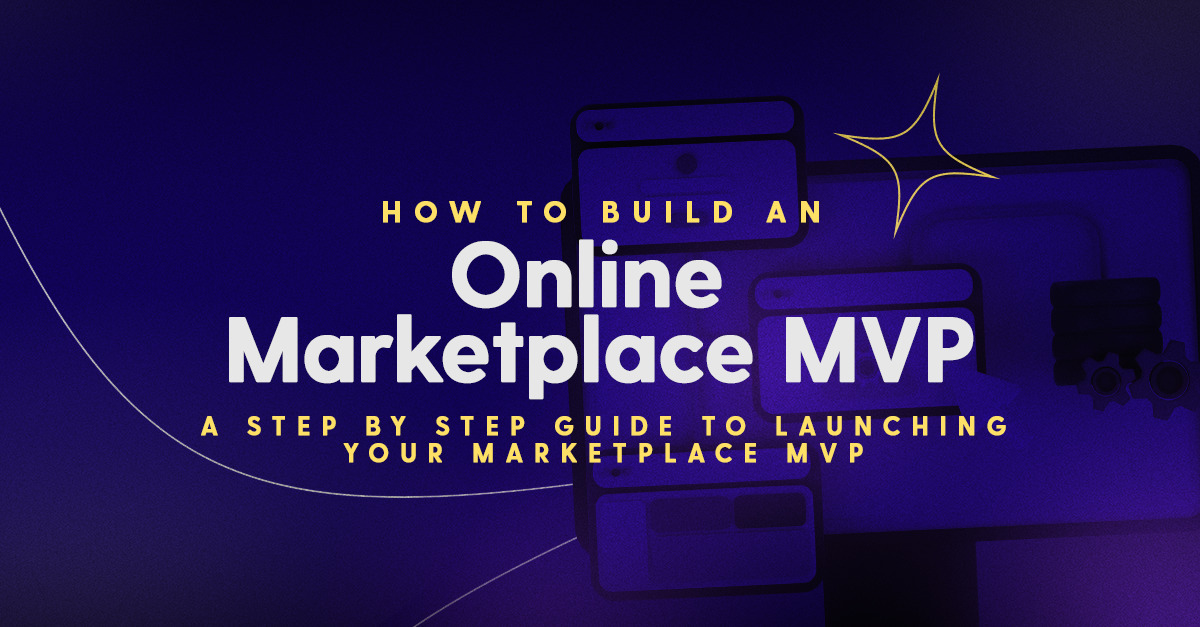A good quality product is not built in isolation.
Rather it is a process of collaboration with your customers.
Therefore, the goal of your early stage marketplace is to launch your online marketplace MVP fast, get initial customers (buyers and sellers) and then talk to those customers, get feedback on your MVP and then iterate fast.
However, even though these are the rules of marketplace development, we see time and time again founders and marketplace operators whose journey’s end before any real user has interacted with their product.
In this article we give you a step by step guide to launching your marketplace MVP, find users and start to get market feedback in days rather than in weeks. The steps we will cover are:
Step 1. Plan your marketplace MVP
As we said above, the primary goal of an MVP is to launch fast, get initial customers, get feedback on your product and then iterate.
To accomplish this goal, you should aim to launch your MVP in as short a time as possible (weeks rather than months). To do this you must ignore any features that are not absolutely essential and focus only on the core functionality that makes people want to use your product.
Launching your marketplace MVP quickly can be scary and many marketplace builders ask themselves, who on earth would use an almost featureless product that has been built in just a couple of weeks?
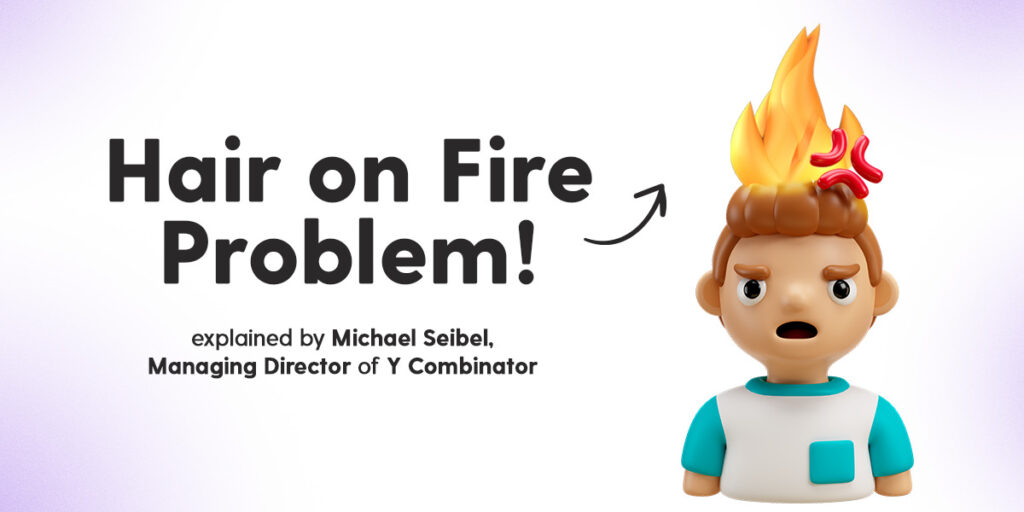
To help product builders think about how to build their MVP, Michael Seibel, managing director of Y Combinator and multiple time founder explains this to founders with the “Hair on fire problem” story.
It goes like this.
How to think about your MVP (the hair on fire problem)
Imagine that you’re a person and your hair is on fire right now, as you are reading this. Now Imagine that I am sitting in the room next to you. Stop and ask yourself, what is the thing that you wish I could sell to you in order to solve your problem?
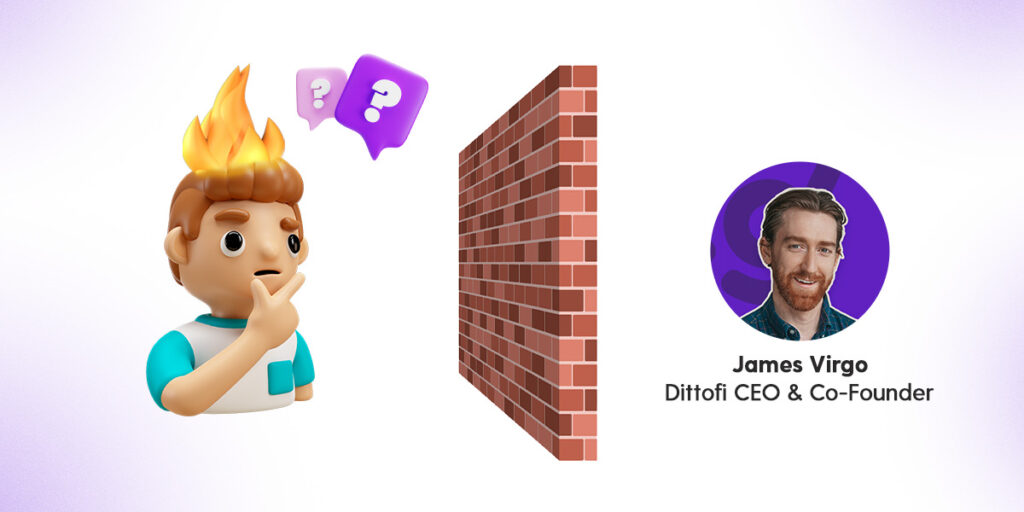
Well, if your hair is currently on fire, you probably wish that I could sell you a fire extinguisher, a fire blanket to smother the flames or maybe a bucket of water. Any of these things would be great products. This would solve your problem immediately.
But I don’t have that. All I have is an MVP which, in this case, is a brick. Would you buy this brick from me and try to use it to put out the flames? The answer is certain – yes you would.
Given that your hair is on fire, you will be in so much pain that you will buy the brick and you will bang it into your head repeatedly to smother the flames.
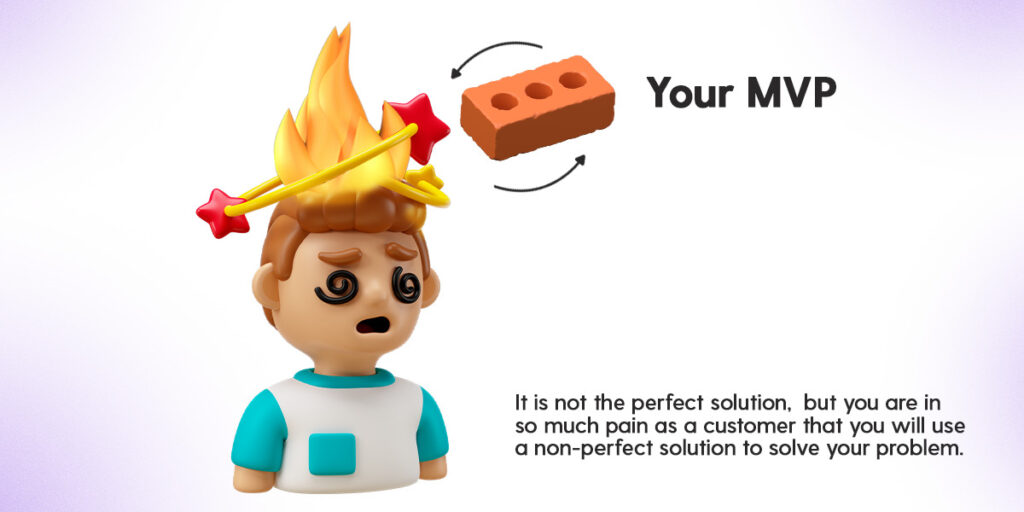
In this example, the brick is the MVP. It is not the perfect solution, but you are in so much pain as a customer that you will use a non-perfect solution to solve your problem.
This is the concept of an MVP. It is a product that barely works, but that speaks directly to a customer that is in such a high degree of pain and that will use your product to solve their problem, even when not all of the features are there.
After you’ve used the brick to put out the fire on your hair, you might give me some feedback. You might tell me that the process of putting out the fire was quite uncomfortable. I will then make an iteration on my product and test using a bucket of water to put out the flames.
However, feedback on the bucket of water might be that it is too wet and it would be better if there was a dryer option. So I think of some sort of blanket that was soft and dry. Through this process of iteration, I arrive at a fire blanket – an efficient, comfortable and dry option to help anyone whose hair is on fire.
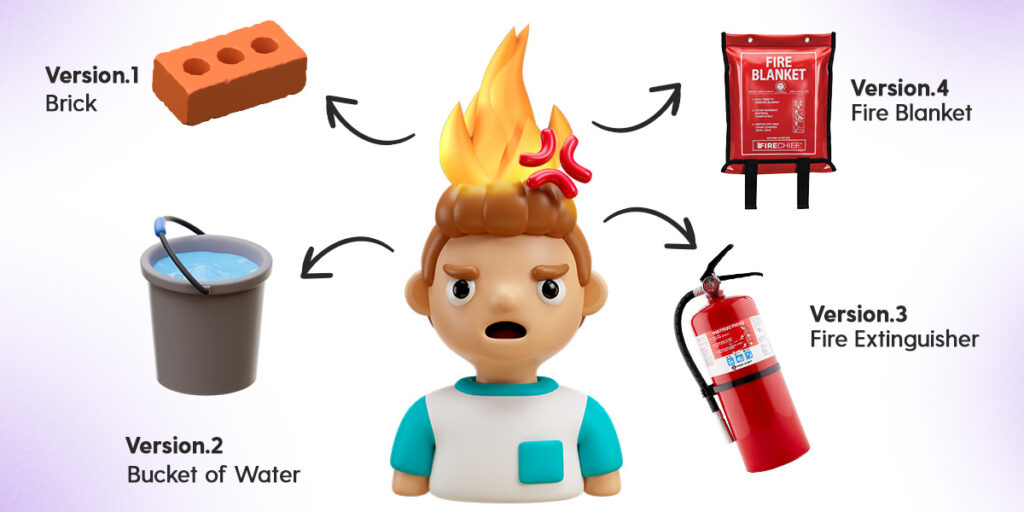
The MVP is therefore just version 1 of your product. It’s something that you think will work, but it might not actually work the way you think it should. Through a process of customer feedback and constant iteration, you then arrive at a product that is market leading in your space.
Planning your marketplace MVP
Okay – so now you understand what an MVP is, you are now ready to start planning out your marketplace MVP.
To do this, take a pen and paper and list out all of the features that you want to include in your marketplace MVP. Approach this task with the mindset that your marketplace MVP is probably going to be like the brick from the story of the founder with their hair on fire so:
- Don’t fall in love with your product idea: It is highly likely that version 1 of your product is going to be like the brick in the hair on fire story. So the goal is to get something out fast and be ready to adapt.
- Time box your scope: Since you need to get something out fast, set yourself a time limit to get the product out, say 3 weeks. Then include only the features that you can deliver in 3 weeks.
- Cut anything out that is not absolutely necessary: After 1 week of development, you’re probably going to realize that you can’t get it all built in just 3 weeks. So go back over your scope and cut out anything that is not absolutely necessary. If there is nothing that is not absolutely necessary, start to cut out things that are necessary. That’s an okay thing to do! Remember, you’re most likely going to be building a brick, so it’s not important if the brick is shiny and made from special material. The important thing is you launch, so that you can learn and iterate.
For some inspiration, here are some famous examples of marketplace MVPs and what features they chose not to include in their MVP.
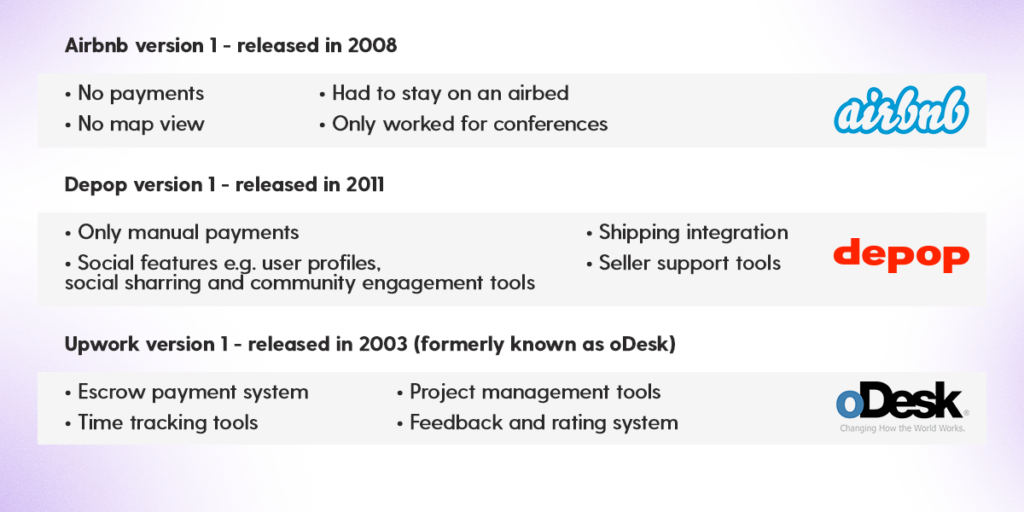
Now – technology has significantly advanced since Airbnb, Depop and Upwork built their MVPs. There is now marketplace technology that you can use to launch a much more feature rich marketplace MVP such as Dittofi’s hybrid no code marketplace builder.
Our platform allows you to launch a feature rich marketplace MVP in just two weeks. To do this, we give you the option to start with a fully developed product, service or rental marketplace template. You can rapidly customize each template using Dittofi’s visual development studio.
Note, each template includes all of the essential features for your marketplace MVP. For example, landing pages, customer onboarding forms, listing pages, payments and so on. Each template includes vastly more features than Airbnb, Depop or Upwork had on day 1.
Furthermore, Dittofi translates all of the visual designs into enterprise grade code. This allows you to access, edit and own all of the source code that powers your marketplace.
Essentially, Dittofi gives you the equivalent of $50,000 worth of marketplace features (compared to traditional code) on day 1 of your marketplace journey. The code is built on a modern, high quality tech stack that you can launch in one click or hand off to developers.
Below are some examples of marketplace MVPs built on Dittofi and the features that they include.
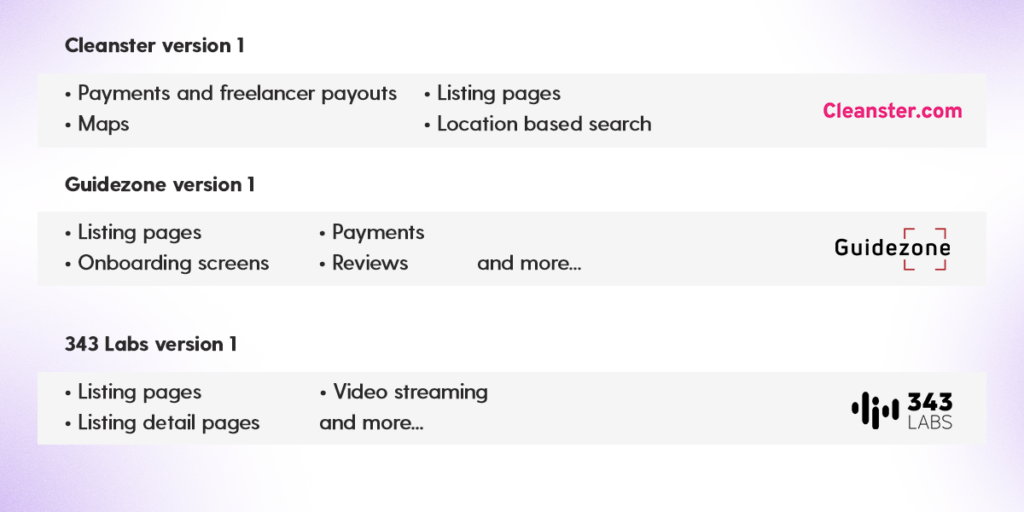
Step 2. Build and launch your marketplace MVP
Once you’ve decided on the feature set to include in your marketplace MVP, the next step is to decide how you are going to build your MVP. There are essentially four options. You can either:
- Hire a development agency
- Find a technical co-founder
- Hire a freelancer
- Use marketplace technology to build it yourself
Let’s examine each of these options now.
Hire a development agency
One of the most common approaches to consider when building an online marketplace is to hire a development agency to code the marketplace from scratch. Development agencies are able to create the scope of your marketplace MVP, including designing the UI/UX of the marketplace and then manage its development. This process will take 3 – 6 months and will cost you approximately $50,000 (if done properly).
Of course, developing a marketplace in this way is time consuming and expensive. Furthermore, there is some risk involved that the agency will fail to deliver on time and inside budget. This approach therefore violates the goal of the MVP which is to launch something fast, get initial customers and then iterate.
Find a technical co-founder
Another approach that we see quite often is to search for a technical co-founder. This is a more sustainable approach compared to hiring a development agency or freelancer. A technical co-founder will bring long term commitment and dedication to your project, share in your vision and actively contribute to your projects success.
However, good technical co-founders are hard to find. This is because a good technical co-founder must possess a unique combination of technical expertise, entrepreneurial spirit and alignment with your vision and values. This scarcity often stems from high demand for skilled technical talent as well as inherent risks and uncertainties associated with joining an early stage venture. Therefore it requires persistence, networking and often a stroke of luck to identify and recruit the right technical co-founder for your venture.
Hire a freelancer
An alternative compared to hiring an agency or searching for a technical co-founder is to hire a freelancer. A freelancer typically comes without the bloated processes associated with development agencies. This means that freelancers will typically be able to engage for a lower initial cost, they can move faster and can adapt quickly to changing requirements.
As with technical co-founders, you need to choose a freelancer carefully to ensure they possess the necessary expertise and reliability to deliver high quality results within budget and on time. Just to labour the point – the goal of the marketplace MVP is to launch fast, so don’t choose a freelancer who offers a slow, antiquated approach to marketplace development.
Use marketplace technology to build it yourself
As discussed in the previous section, nowadays it is possible to build and launch a feature rich marketplace MVP using marketplace technology.
As we have already seen, marketplace technologies are specialized solutions that you can quickly configure in order to power your online, multi-vendor marketplace. There are two main types of marketplace technology:
- Open source marketplace technology
- Software as a Service (SaaS) solution
Open source marketplace technology allows you to build highly bespoke marketplaces however, they require a lot of time and developer skill to configure. In contrast, SaaS solutions are heavily limited, but they are fast to set up. This poses a problem for companies looking to build a unique solution at high speed.
More modern hybrid solutions such as Dittofi solve this problem. Through our unique hybrid approach, Dittofi combines the best of rapid MVP development with the ability to customize your marketplace fast, without coding and with the flexibility of custom code.
Using Dittofi, you can build your marketplace MVP in just 10 hours and without having to write any code. Dittofi then allows you to iterate on your marketplace fast, without coding and without any limitations. This allows you to remove dependencies on expensive and hard to find developers and to incorporate customer feedback quickly, staying ahead of the competition. Finally, Dittofi transforms all of your visual designs into code that you can either continue to edit in an entirely visual way, or hand off to developers.
Step 3. Find early adopters
Now that you have built your marketplace MVP, the next step is to find early adopters. To do this, think back to when you were validating your idea for a marketplace. Hopefully at that point, you were solving a problem that either you have or that someone you know has. This means that you probably already know who your early adopters are.
The advice given to new marketplace founders and operators is to start off by doing things that don’t scale. This means that you will hand recruit your early adopters, taking these from people you already know, from online groups or offline events.
The next thing to bear in mind is that there is no benefit to you to make these first customers hard to get customers. You should look for customers who intensely have the problem that your marketplace has been designed to solve and are willing to work with an early stage startup to solve this problem and are willing to pay to solve the problem that they have.
You therefore need to qualify your early adopters as people who urgently need the solution that your marketplace provides, that are willing to pay and are willing to move quickly. For all other customers, it is okay to let them go for now and focus on trying to recruit them later on when you have a more mature solution.
Lastly, pick a side of your marketplace (either your buyers or sellers) and actively recruit this side first. It is normally better to start with the hardest side of the marketplace first. This will be the side where you are most constrained due to wider market dynamics.
Step 4. Gather Market Feedback
Now that you have your early adopters signed up and using your marketplace, it’s time to gather feedback from your users.
Many marketplace founders and operators miss the point of an MVP. They have an idea in their head for a great product. One that has all the bells and whistles of a fully functional, highly advanced marketplace. These marketplace builders tend to think unless they’ve built the complete idea, what is the point in getting feedback on a barely functional MVP is going to be pointless.
The reality is that as great as your idea is, your idea should be flexible. This is because the grand idea that you have might turn out to be not what your customers want at all. Therefore, you should focus very closely on working out how to use your product to solve the customer pain point you’ve identified. This leads us onto step 5, which is to iterate on your product until you have a solution that your customers love.
Step 5. Iterate on your product
After launching your product the next step is to iterate.
Iterating is the process of making adjustments to your marketplace MVP based on customer feedback. For example, adjusting the search filters or refining the messaging features based on user feedback—making small tweaks to improve the platform’s usability and user experience while still focusing on solving the central problem for your buyers and sellers. It’s about fine-tuning the marketplace to better serve the needs of both sides.
Another term that is often used interchangeably with iterating is “pivoting”. However, iteration and pivoting are completely different concepts. In the first case, iterating involves making small adjustments to your software to improve it for your identified customer pain point. By contrast, pivoting involves taking your product and trying to apply this to another market entirely. Pivoting is therefore far more dramatic.
Thus, if your customer and pain points are real, but your product doesn’t work for this customer and their pain point, you need to fix the product – don’t just pivot so as to try and apply your product to a different market that it was not built for.
How much does it cost to build a marketplace MVP?
The cost of building an online marketplace MVP will differ depending on several factors such as the number of features you want to choose, if you code from scratch or use a marketplace technology, do you hire an experienced development agency or a less experienced freelancer.
Based on our experience however, a typical marketplace MVP will cost no less than $50,000 and as much as $250,000 when developed from scratch. This will include all of the must-have features such as:
- Buyer and seller landing pages
- User onboarding forms
- Easy search and navigation
- Listing pages
- Payments integration
- User profiles
- Managed listings
- Reviews
Alternatively, if you use a marketplace technology like Dittofi, you can build a better quality, more feature rich marketplace MVP for approximately $3,588 in the first year. The cost breakdown for this is shown below and is compared to traditional development.
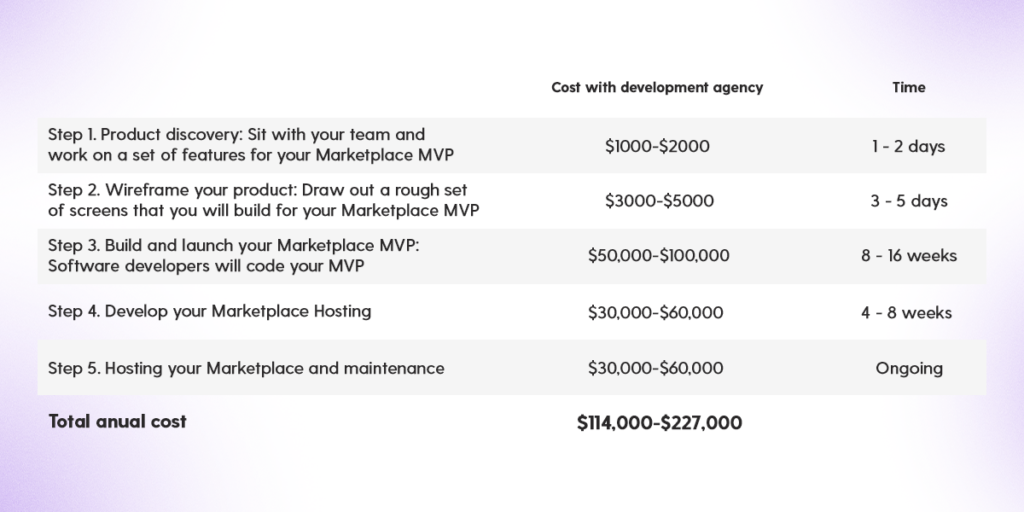
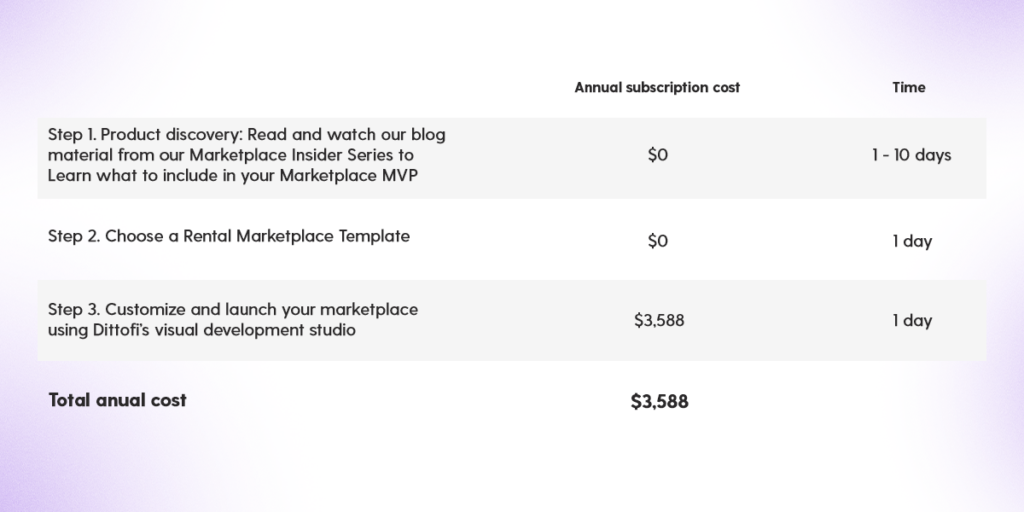
Dittofi marketplace MVPs are more feature rich and can include features that are specialist for product, service or rental marketplaces.
Features of an online marketplace MVP
As we have already seen, the goal of the marketplace MVP is to launch fast, get initial customers and then start to iterate on your marketplace. The first version of your marketplace should therefore contain only the bare minimum features that are required to solve the buyer and seller problems that you’ve identified.
Below is a list of features that are commonly included.
Buyer and seller landing pages
Every marketplace needs two landing pages. One for the buyers and the other for the sellers. These pages are the face of your marketplace. The goal of the buyer and seller landing pages are to communicate the value proposition of the marketplace.
Below are three examples of buyer and seller landing pages for Etsy, Airbnb and Upwork.
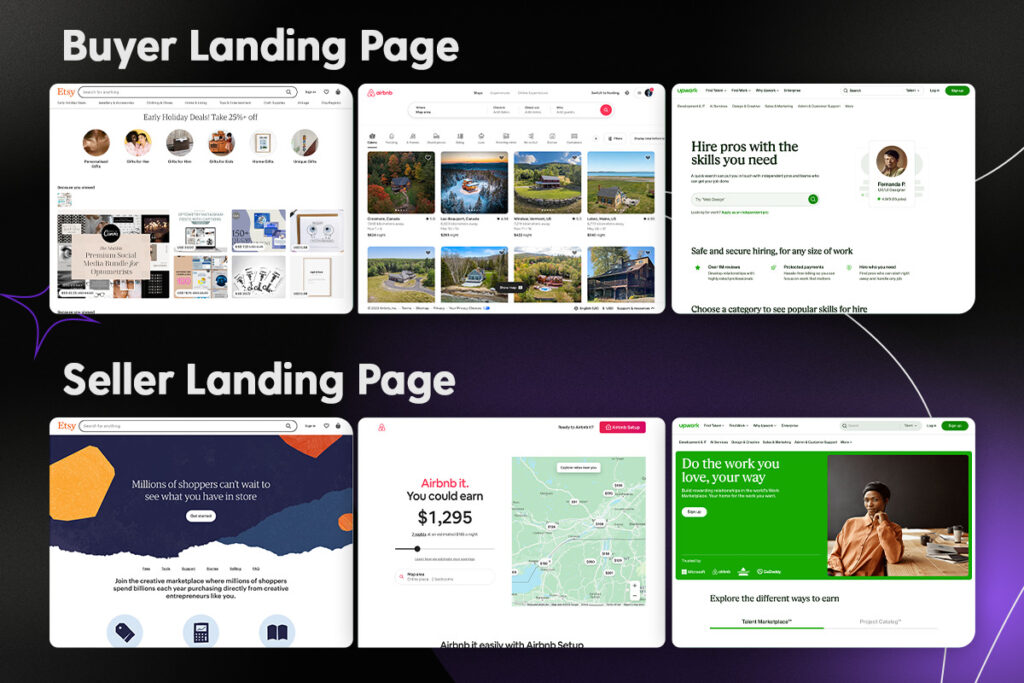
User registration
Whilst the buyer and seller landing pages are the face of your marketplace, the user registration is the door to your marketplace. You need to separate registration screens for your buyers and sellers.
It’s good to add single sign-on options for example, sign up with Google, Apple, Facebook, Twitter and so on. These can help increase the number of sign ups to your marketplace.
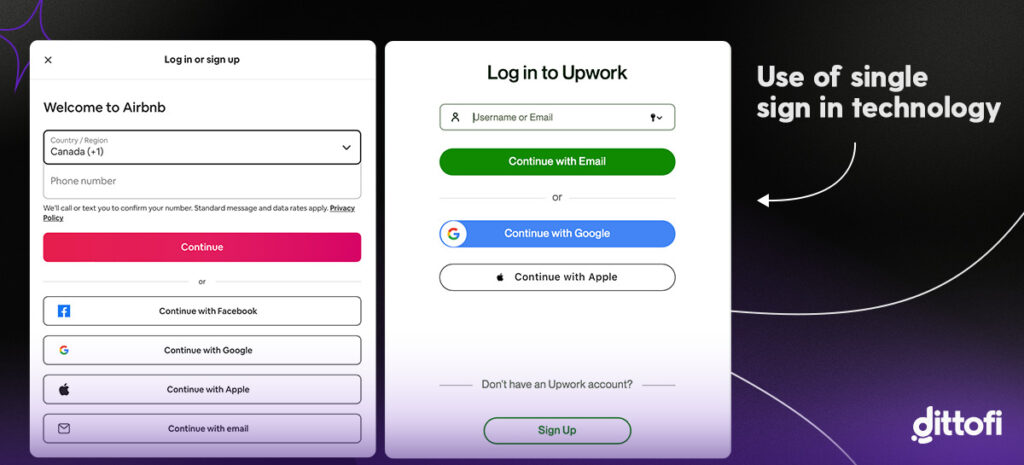
User profiles
The user profiles section is important for both buyers and sellers on your marketplace. The buyers need to know some key information about sellers and vice versa.
We often hear from marketplace developers that buyers’ profile pages are not necessary. However, especially for service and rental marketplaces, buyers profile pages are incredibly important. For example, a property owner on Airbnb would undoubtedly want to know what is the background of the person renting out their marketplace.
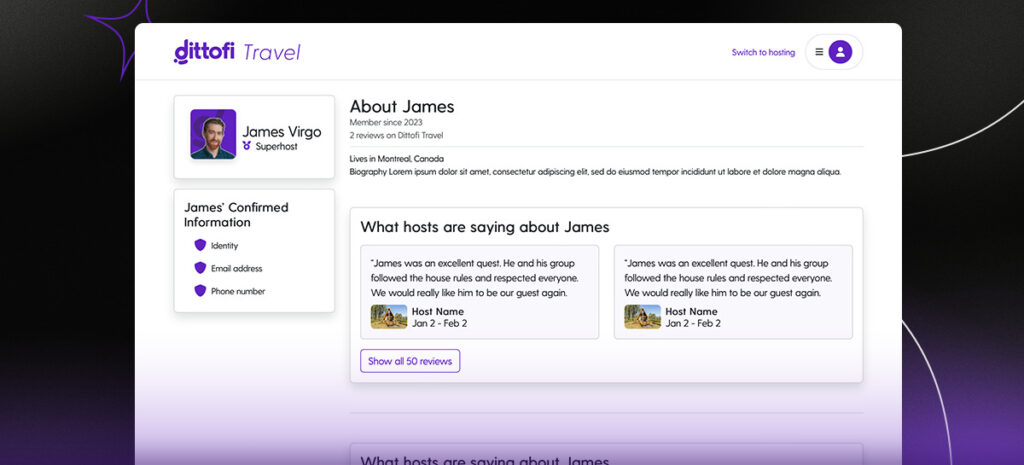
Easy search and navigation
A two sided marketplace has a lot of products and services.
To help buyers quickly navigate through the marketplace and find what they are looking for, you need to be able to organize your products and services into different categories. Users then need to be able to easily click through these categories or use free text or location based search options.
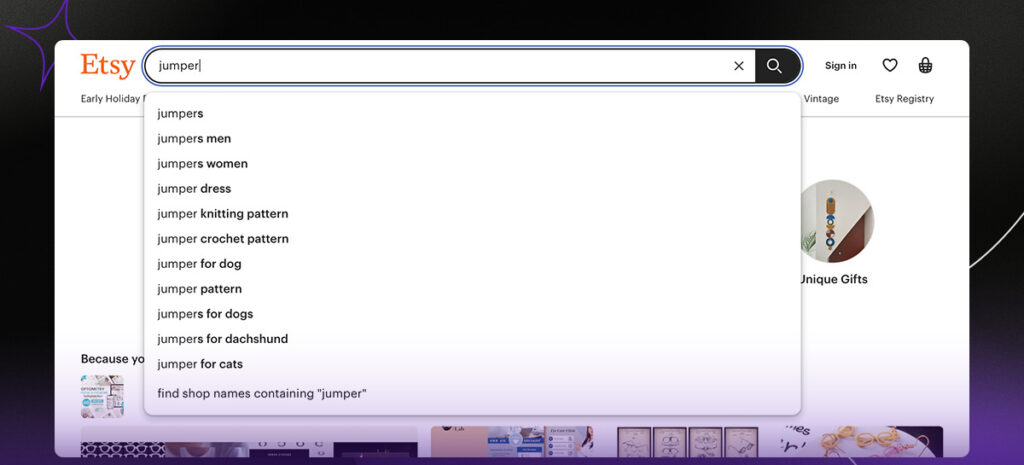
Routing pages (listing and listing results pages)
Routing pages (listing and listing results pages) play a hugely important role in product and service selection on a marketplace. Listings pages organize and present multiple product and service options in a single page. They normally include search tools to help buyers navigate the pages.
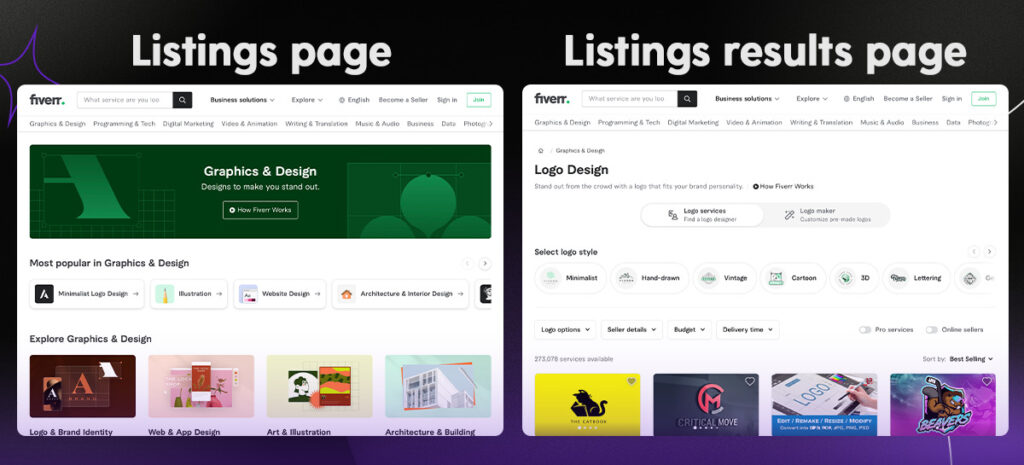
Listing page
When a buyer clicks on a listing they are taken to the listing details page. At this point, we can assume that the buyer has expressed interest in the product or service. The goal of the listing details page is then to help supply the buyer with all of the information that they need to make a decision to purchase or rent the product or service.
The listing details page should be attractive, functional and maximize the potential for lead generation through public searches.
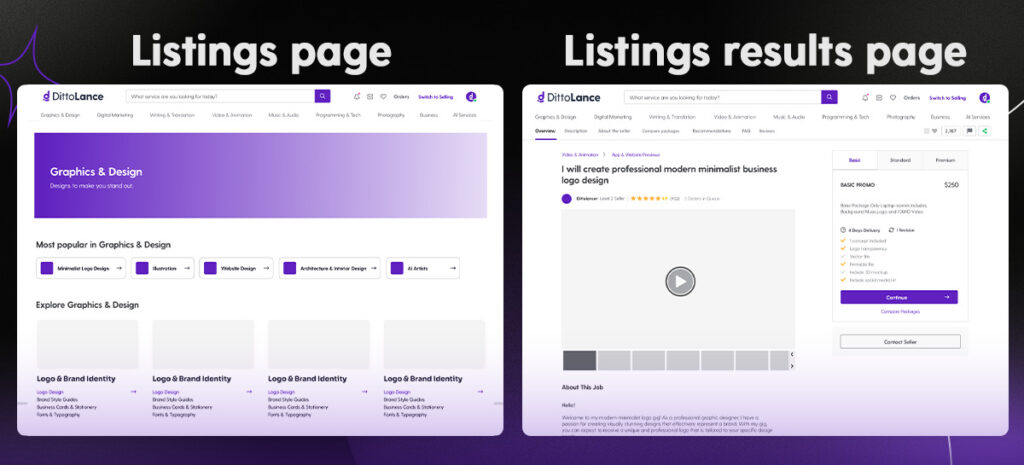
Payments integration
The purpose of an online marketplace business is to generate income for the platform and for your buyers and sellers.
To do this, you need to choose a marketplace business model and integrate a secure method of taking payments such as Stripe. Most marketplace MVPs start with a commission based business model and charge this to their side which is least constrained.
Manage listings
The “manage listing page” on a multi-vendor marketplace is a dashboard for users (typically sellers) to administer their listings, products, services, or offerings on the platform. The primary purpose of this feature is to empower sellers with tools and features to efficiently manage and optimize their offerings.
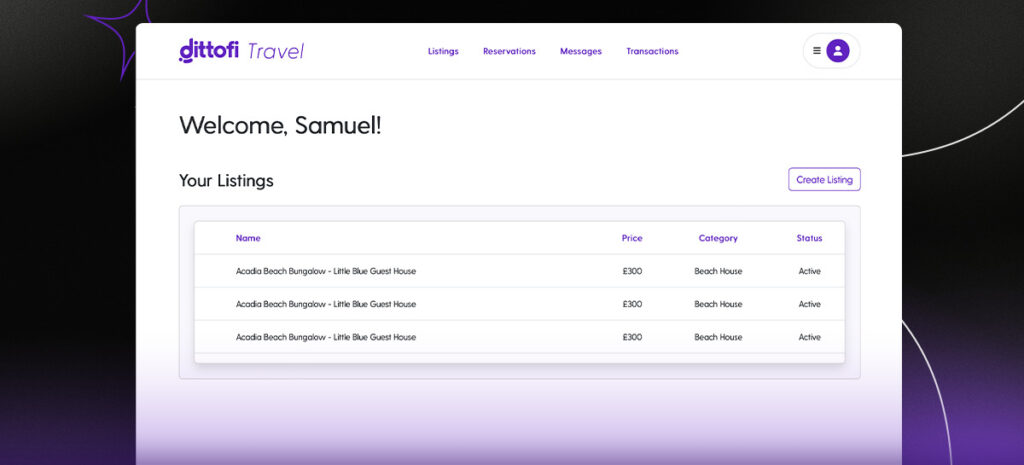
On-platform communication
Giving buyers and sellers the option to communicate with each other on the platform can help promote transactions. This is because buyers and sellers can ask questions of one and other on the platform.
On-platform communication can also help to prevent marketplace leakage which can lead to a massive loss in revenue for the marketplace.
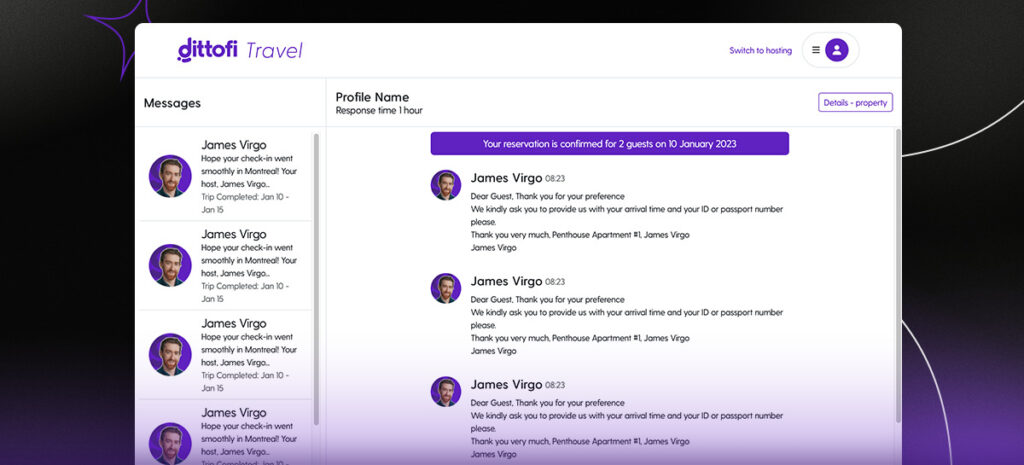
Two sided reviews
After a transaction has taken place, the buyers and sellers should be able to leave feedback about how each party behaved during the transaction. In case of any problems, the marketplace operator can act as a mediator in the disputes between the consumer and the supplier.
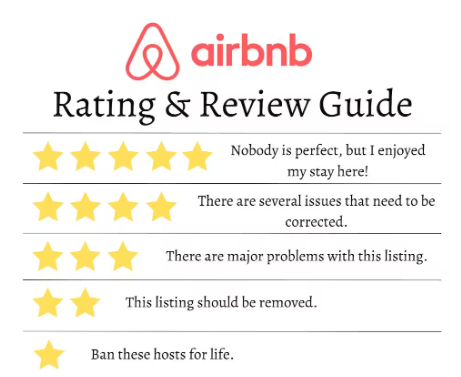
Search engine optimization
Making sure that your marketplace MVP is setup for SEO is important. This is because it takes a long time (3 – 6 months) for search engines such as Google to start ranking your pages. You should therefore choose a technology for your marketplace MVP that makes it easy for search engines to crawl the pages, as this is something hard to add later on.
Note, many professional developers overlook this requirement because they don’t have have technical marketing experience.
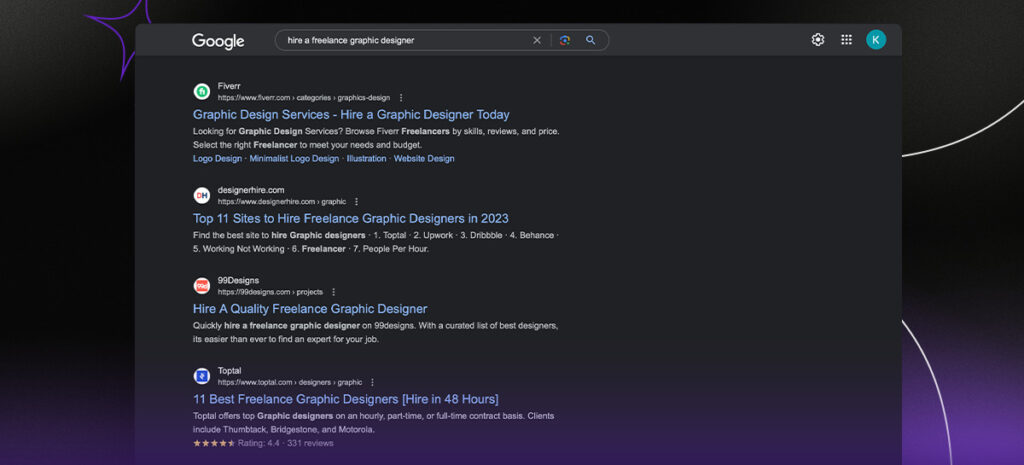
Marketplace hosting and data security
Your marketplace should be available for users to access 24/7. Ideally you want to run your marketplace on a specialized hosting service that is robust, efficient and performant. This is so that you don’t have to worry about server maintenance, security or hardware upgrades. Your hosting configuration also has an impact on how discoverable your marketplace is.
Dittofi offers two hosting services called the Dittofi Cloud and Dittofi ADS. Dittofi Cloud is a service that allows you to run your marketplace on our own servers. Dittofi ADS allows you to export Dittofi’s hosting configuration and to deploy this into your own hosting environment. This can save you literally millions of dollars in infrastructure costs.
Hacks for building your marketplace MVP quickly
Next up, let’s take a look at some recommended hacks for building a marketplace MVP extremely quickly.
1. Time box your scope
Decide when you want to launch. For example, if you want to launch in the next three weeks, take the list of features that you want to build and include only those that can be built in a three week timeframe. This will allow you to remove all of the features that you cannot build in under two weeks.
2. Write down your scope
One of the things that can happen when building your MVP is something called “scope creep”. This happens when you start to include new features that were not in your original scope. Most people don’t write down their original scope and so, this makes it very easy to start adding new features to it. However, you need to remember that most marketplace founders never actually launch so, write down your scope and stick to it!
3. Cut out anything not essential
A week into your three week sprint you are probably going to realise that you added too many things to your scope and you realize that you’re probably not going to meet your deadline. This is okay – just cut out the features that are not important and, if there are only important things, then cut out the things that are important.
Again – the important thing is to hit the deadline that you set for yourself.
4. Don’t become overly attached to your MVP
So many marketplace creators fall in love with the vision for their MVP. They get attached to every little feature and refuse to go live until their vision has been realized. However, think back to the first version of Airbnb, Depop or Upwork. None of these successful marketplaces started out by developing their complete vision. Instead, they got something basic out into the world and then iterated on it.
So – don’t become overly attached to your MVP. It is just step one in your journey and a good way to start a conversation with a prospective customer.
Conclusion: Take an iterative approach
Building a marketplace can feel intimidating. There are a lot of steps that you need to take in order to find success. It also takes time to find success. For example, Airbnb started in 2008 but didn’t gain widespread popularity until 4 years later in 2012. That’s four years of learning and product iterations.
However, don’t be disheartened by this. Using proven marketplace technology like Dittofi, you can jumpstart your MVP, at a super low cost. Then, onboard paying customers and stick closely to the iterative approach.
Building a marketplace is an exciting and empowering thing to accomplish. There is no better feeling than when you start seeing buyers and sellers make transactions on your marketplace and you realize that you’re no longer reliant on anyone else to make income.
If you would like to book a call to discuss how Dittofi can help you build your marketplace business, schedule a free consultation with one of our marketplace experts.
And in case we don’t speak, good luck with your marketplace development!
Become a Marketplace Insider
Join our inner circle for exclusive insights, coveted trade secrets, and unparalleled strategies – your journey to marketplace dominance begins here.

